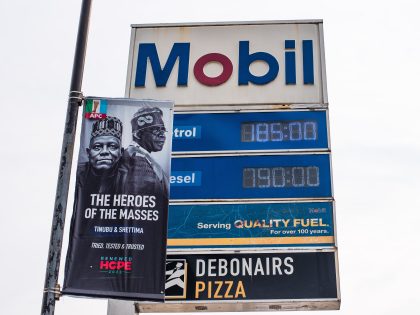Cape Town is Three Countries: Curatorship in times of load shedding

“Load shedding” is a nice South African term for daily deliberate shutdown of electricity supply in parts of the country due to shortage in supply. The following are three short stories from art exhibitions that took place on one week of May in the suburb of Woodstock, Cape Town. Torches and candles provided.
…
1. FRIDAY / GREATMORE STUDIOS
The lights went off almost exactly at 6pm, the hour Khanyisile Mbongwa was about to open her new group exhibition Revisiting The Latent Archive in Sites. No one at Cape Town’s Greatmore Studios looked too worried, not the organizers and not the guests, who were greeting and small-chatting to each other. The previous event they hosted, Monadology music performance, was postponed by two hours while waiting for electricity to come back. The event before that, a screening of a documentary about James Matthews, turned into an open talk with the poet. Three hours after the due time, with the return of the power, the screening started. Curatorship in times of load shedding brings it down to the basics of the reason why we bother to gather. The idea behind a cultural event takes the lead over the form, and improvisation becomes the best strategy. You can’t dwell on technicalities here.
…

The reason we gathered that evening was to have conversations about the affairs of current time and space. In the words of Khanyisile, the exhibition explores the concept of space as a hidden archive that can be awakened and re-imagined through art. To provide a taste of what is to come, guests were welcomed as they entered with an exhibit of a bread box, a powerful sculpture made of rusty bars. Breadwinner by Bronwyn Katz tells the story of the artist’s father, whose life represents the local duo of money and security. “My father, the financial provider of my family, spent a portion of his life working as a welder and specialised in the making of burglar bars and fencing. Breadwinner speaks of the toil that accompanies the provision of basic needs. The concept of access and in-access of basic needs is referenced by the burglar barred lid of the bread bin. The lid of the bread bin is made heavy making it difficult to open the bread bin. This refers to “the difficulty with making a living” writes Katz. This is the new generation of South African artists, many of them freshly graduated from the local art school, and this is what they are talking about.
…
Standard long white candles were installed in line at the feet of the exhibition walls, erecting from empty bottles of Castle beer – a popular solution with unique local aesthetics. The opening performance started on time, and the candle light was perfect for it. The intimate atmosphere contributed to the dramatic dialogue between the two performing poets who approached the dozens of guests with open and direct conversations in English (Nique Floe Sithole) and isiZulu (Palesa Sibiya) about the state of their site-specific affairs.

“I always wanted to exhibit with candle lights, but you know UCT – they are so strict”, said with a smile Richard Mabula, who will be leaving the country soon for the first time. In August he will fly to The Dominican Republic to study further and practice hyper-realist painting. His large scale piece of almost real-size naked young lady lying in a black void seemed to be comfortable with the candle lights. Her eyes were constantly looking back at the exhibition room and at those who look at her, her background dissolving into the wall.
…
Mingling and socializing in semi-dark romantic lighting was a strange experience. The effect on the social behaviour resulted in more attention to the artworks, rather than the faces of the audience members (which steal the show in many opening events). It did provide more opportunities to stand alone and observe the exhibiting room.
‘It makes me feel a bit lost to stand in front of an artwork without a text explanation’ mentioned Khoi, a doctor in training from Nairobi. She stood in front of Rory Emmett’s Lest We Forget work, and started sharing her thoughts about the use of colours on only one of the figures. ‘Maybe it’s better. It makes me think and take whatever I want to take from it”. A lady, who was standing near, started telling us about the news story which inspired those images – a mobile phone footage of a man who got harassed by security in public. She said that it was a big story and that he was stripped to naked, the policemen were punished, the video is online and we must watch it. That gave Khoi an answer to the question of the colours. I preferred the retelling of the story by the artwork, which takes the voyeurism out. A conversation as a great substitute for a label.
…
The exhibition served as an alternative sheet of newspaper, mixing history with future. When the violent event happened doesn’t matter. According to the curatorial thread, now is the right time to talk about witnessing violence; or about money and race, as Bronwyn and Richard do. Or about tradition and culture, as other participating artists show. Those moments or places that the mainstream news do not tell us about until something extraordinary happens, those which we ourselves see through, were the subject of Robyn Pretorius’ wall. Her hyper realistic paintings capture and document the overlooked spots of town and ‘the energies they harbour’ as she says. They carry a familiar feeling of collectively abandoned corners. A couple of visitors were debating if it is Mowbray or Rondebosch subways passage in one of the paintings. To me it looked like Observatory. In the texts provided it said Bellville station. Does the exact geography really matter?

The eye gets used to the weak candle light. People get used to the load shedding reality. It is part of the everyday here. Some keep on bitching about the inconvenience and ill governance, others romanticize it with tweets about book reading in candle lights. Some print out the timetables and put them on the fridge, others don’t bother to check. Khanyisile has no time to bitch or complain, and she is much too critical to romanticize public defects. She works with them, and it seems to work for her.
…
At 9.30pm the lights in Woodstock were turned on, accompanied with vocals of joy. It was almost perfect timing to end the exhibition opening ceremony. I’m not sure if I want to see Richard’s laying girl’s look in the bright white lights.

2. THURSDAY / ARTMODE
Not every cultural event could turn a three hour power shutdown into a positive twist. It is hard to imagine what would do in the same situation the curators of ArtMode, an exhibition event that happened the same time a day before on the other side of Woodstock, the emerging art district of downtown Cape Town.
Forget about intimacy and politically charged spaces, about tightly conceptualized curatorship of a group exhibition, forget about candle lights. ArtMode looked and felt more like an expo, a mega Indaba of artistic stalls or corners. Like in a retail space – though an exclusive and cool one – the message was variety, without a thematic thread or conversations between the participating exhibits.
The concept was to have the artists present and working as a part of the exhibition – the increasingly popular ‘Live Art’ genre. Some took it literally and installed a stand with canvas and set down painting while answering questions. Alice Angela Toich was the most classic of them. She looked like a painting herself: wearing a black gown with paint stains, dark shiny hair with her back to the crowd and her face towards a classic composition of still life – dramatic fabrics, deep and dark colours and a vase of Protea flowers. Brighter and lighter version of a live artist was Samantha Appolles’ vision of wishful joy. She exhibited colourful portraits of beautiful confident individuals, young people who own their identity: “my efforts are to break racial stigmas and long-standing oppressive dogmas by using a positive vision of a more expressive human race”. They are imagined, she tells. Imagined poster boys and girls for the born free generation? As opposed to the portrait of omnipresent Nelson Mandela on an opposite wall, the faces on Samantha’s canvas and their spirit felt refreshing and very much real.
The talk of the exhibition was Maurice Mbikayi – who took the notion of live art to another level, while sending the most clearly political content. He creates sculptures of bags and dresses from reused electronic waste, such as computer keyboards and cables, and wears his artworks. Creating spectacle from the unwanted. He provides his audience more opportunities to take photographs with the works, to use their phone cameras before they end up in the same piles as the old PC parts. Like the Fight-Club film heroes, he re-sells the waste to those who over consume. And he makes a Disney World experience out of it.
…
Jan Ludik’s corner of the exhibition space looked like a deserted living room in Sea Point. With no artist present and a few pieces of domestic furniture that might have been left there from the previous life of this space as an expansive interior design franchise. From a distance the works on the walls looked like vintage oil paintings of landscapes from the antique shop next door, heavy framed with stripes of gold. A closer look would reveal details too contemporary and ordinary for the genre – views of Sea Point, the well-off suburb on the other side of Signal Hill. It is those ‘classic’ houses one would typically find the original old-school landscape paintings that Jan references. In the renovated gentrified hangar they looked dislocated — a feeling that was highlighted by hanging them side by side with abstract conceptual works. Both the technique and the themes were contrasting. Ready-made work of screws referencing the Marikana killing of protesting miners wouldn’t naturally fit into the conversations of that conservative regulated and depoliticized space. Nor the cubist drawing of a washing line, which is a prohibited exhibit on the streets of Sea Point. A hint to a living contradiction?
…
An act that would benefit from intimate candle lights was The Morning Pages performance. The day before their gig in another local venue was cancelled due to an expected load shedding. The Southern suburbs based band has been around for two years, experimenting with creating audio-visual settings that carry the audience into a spiritual journey. The shop that hired out the projector for them to use on that day for the visual part, has refused to refund the money. Their name is borrowed from a term referencing an in-between state of being in the first moments of one’s awakening from sleep into awareness. Their feeling of séance, familiar from house jams and small spaces like Tagore’s Observatory, struggled to work with the bright lights in the corners around and the spaciousness of the hangar. It was hard to concentrate and tune into their frequency, like trying to have a deep philosophic conversation in a mall.
…
The ‘creative live collaboration of art and music’ was actually held in a mall – The Palms complex in Woodstock. Behind a car parking entrance hides an indoor world that looks like an outside world, but cleaner and safer. In a huge, industrial and beautiful hangar floats a private-public space. The Palms is a home to exclusive services, such as ‘dial-a-surprise’ online gift shop, fabric and vintage decor and destination-management tourist bureau. The designers of the space try to make it look like an outside street with paved floors, inner balconies, a bridge and elements that copy the old English style of street signs and lamps. They even have features that the city outside doesn’t have, such as benches. In the land of The Palms there is no poverty, no street people sleeping in corners, no one asking for coins, no litter like nik-nak empty bags flying in the notorious Woodstock wind. There is no wind at all actually, which makes it funny to see one of the shops putting a sign on the door ‘closed on account of weather’. And there are no palms. It is a wishful, clean, rich and sterile world guarded from the outside by contract security men. Shops leave stuff outside of the closed doors, no one will take them. One shop has a sign offering ‘load shedding sale’, promising discounts in times of power failure. Khanyisile is not the only one rolling with the electrical punches.
…
3. SATURDAY / GOODMAN GALLERY
The safest way to go about load shedding is to do a morning event. On the same weekend Woodstock hosted another exhibition opening, a curated show by a returning Capetonian Natasha Becker. After more than a decade in the academic and art worlds of United States, Natasha comes back to live and work in Cape Town for a while, celebrating the move with an exhibition. Under the title Speaking Back she curated a collection of stories, told by female artists as her homecoming entourage. Most of the African participants’ biographies reveal an opposite direction of movement – from various places of birth in Africa to new places of life and work in the US and Europe. “Born in Cairo, lives and works in New York…born in Johannesburg, lives and works in Berlin… born in Kenya, lives in London..”. Becker’s return to Cape Town is an exceptional step among her colleagues’ stories of life. A new trendsetter?
…
Many of the stories in the exhibition were of the fantasy genre, combining wild childish imagination with deep political awareness. One of Natasha’s critical fairies was ruby onyinyechi amanze (”born in Nigeria and is based in New York”). She exhibited two big sheets of paper, so big that you can imagine the artist sitting on one, drawing and trying not to leave a mark of her knees. Her techniques are mixed and carry playfulness – grey pencil, yellow marker, glitter and pasted cut-outs combined. The sheets look like drafts, unfinished, not serious. Isn’t criticism supposed to be serious and bitter? ruby’s psychedelic fantasy – with headless, disproportional dream-like creatures – seems to have too much fun for a critical text.
…
The playful, futuristic, sharp, critical and imaginary discourse was projected also from the works of Otobang Nkanga (”born in Nigeria and living in Belgium”). Nkanga’s artist book featured childish and unfinished cropped out figures of sexual harassment and small houses wrapped in wire; body-less hands in mines and factories. Otobang creates pages that make social critique look like fun. If I would dare to speak back that Saturday morning, I would grab the plastic dildo that hang Adejoke Tugbiyele in the entrance, and use it as a microphone to ask if I may leaf through the book’s colourful pages, which lay casually on the table, suggesting a touch is allowed. Adejoke (”American artist and activist of Nigerian descent”), might have supported my mini protest. Along with the dildo she exhibited a dozen of imaginary demonstrations, mixing real slogans with tale-like figures and situations in drawings of pink lines. They presented a cool futuristic-journalistic essay, that can even look cute.

The spirit of playfulness was not contagious – I haven’t seen anyone touch the artworks, and I did not dare myself. Goodman Gallery, which hosted the exhibition, is one of the biggest names in commercial contemporary art scene of South Africa. With this status comes a feeling of almost a museum, ‘respectful’ institution with less freedom for a guest, as implied in the custom restrictions such as ‘don’t touch’ or ‘don’t photograph’. Otobang did have a hint of suggestion to touch, and yet the behaviour in such spaces is completely self-policed, and is mainly based on the fear of social shame.

Most of the exhibition stories could have been from out of space, or at least out of the ordinary. There was a universal feel about the exhibition. The space could have easily been sent by a magic technology to New York. As far as its’ locality concerns it could fit into any black consciousness town in the world. The most Capetonian work would be Arlene Wandera’s I’ve Always Wanted a Doll’s House – a small model of a Victorian architecture house that could have been in Woodstock. Amorphic black figures of un-personalized humans climbing-in through the windows, as if invading. The house is looking cute and hunted, repainted white with its paint dripping down. Funny enough it was placed in a dark corner of the gallery, by a beautiful video art projection (of Ellen Gallagher). At the corners of the dark doll house were placed two torches, suggesting for the audience to light inside into the inner rooms. Another test of audience playfulness or a site-specific joke on load shedding?
*This post appeared originally on the author’s Yalla Shoola tumblr page. All photos are by the author unless otherwise noted.























